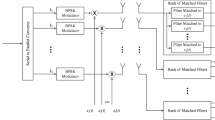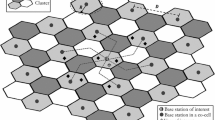Abstract
This paper analyses and compares the average bit error rate (BER) of different multiuser detectors (MUD) in the uplink of a multicarrier code- division multiple access (MC-CDMA) system. In particular, maximum likelihood, zero-forcing, minimum mean-square error and interference cancellation-based multiuser detectors have been analysed for the special case of uncorrelated subcarriers. The derived BER expressions are based upon previous results on diversity combining and also on recent findings on multiple input multiple output (MIMO) architectures. The subcarrier correlation is considered in the context of physical parameters currently under discussion for future wireless systems to give an indication up to what extent the assumption of uncorrelated subcarrier fading is plausible.
Similar content being viewed by others
References
Yee, N., Linnartz, J.-P., & Fettweis, G. (1993). Multi-carrier CDMA in indoor wireless radio networks. In Proceedings of the IEEE int symp. on pers., indoor and mob. rad. comm., Yokohama, Japan, pp. 109–113.
Hara S., Prasad R. (1997) Overview of multicarrier CDMA. IEEE Communications Magazine 35: 126–133
Cadwell R., Anpalagan A. (2005) Meeting mobile’s demands with multicarrier systems. IEEE Potentials 24(5): 27–31
McCormick A., Al-Susa E. (2002) Multicarrier CDMA for future generation mobile communication. IEE Electronics and Communication Eng. Journal 14: 52–60
Fazel K., Kaiser S. (2003) Multi-carrier and spread spectrum systems. Wiley, New york
Fazel K., Kaiser S. (2005) Multi-carrier and spread spectrum systems. Wiley, New york
Shi Q., Latva-aho M. (2002) Exact bit error rate calculations for synchronous MC-CDMA over a Rayleigh fading channel. IEEE Communications Letters 6: 276–278
Shi Q., Latva-aho M. (2002) Accurate bit-error rate evaluation for synchronous MC-CDMA over Nakagami-m-fading channels using moment generating functions. IEEE Communications Letters 4: 422–433
Verdu S. (1998) Multiuser detection. Cambridge University Press, Cambridge
Steiner, B. (1997). Uplink performance of a multicarrier-CDMA mobile radio system concept. In Proceedings of the IEEE vehicular tech. conf., Phoenix Arizona, US, pp. 1902–1906.
Zhu X., Murch D. (2002) Performance analysis of maximum likelihood detection in a MIMO antenna system. IEEE Transactions on Communications 50: 187–191
Chiani M., Win M., Zanella A. (2003) Error probability for optimum combining of M-ary PSK signals in the presence of interference and noise. Transactions on Communications 51(11): 1949–1957
Zanella A., Chiani M., Win M. (2005) MMSE reception and successive interference cancellation for MIMO systems with high spectral efficiency. IEEE Transactions on Wireless Communications 4: 1244–1253
Cai X., Zhou S., Giannakis G. (2004) Group-orthogonal multicarrier CDMA. IEEE Transactions on Communications 52: 90–99
Proakis J. (1996) Digital Communications (3rd ed). Mc-Graw Hill, Englewood Cliffs, NJ
van Zelst, A. (2004). MIMO OFDM for wireless LANs. Ph.D. dissertation, Technische Universiteit Eindhoven.
Craig, J.W. (1991). A new, simple and exact result for calculating the probability of error for two-dimensional signal constellations. In Proceedings of the IEEE MILCOM’91 conf. rec., Boston, MA, pp. 25.5.1–25.5.5.
Abramowitz M., Stegun I. (1970) Handbook of mathematical functions with formulas, graphs, and mathematical tables (4th ed). Dover, New York
WintersJ., Salz J., Gitlin R. (1994) The impact of antenna diversity on the capacity of wireless communications systems. IEEE Transactions on Communications 42: 1740–1751
Leon-Garcia A. (1994) Probability and random processes for electrical engineering (2nd ed). Addison-Wesley, Reading, MA
Mallik R., Win M., Chiani M., Zanella A. (2004) Bit-error probability for optimum combining of binary signals in the presence of interference and noise. IEEE Transactions on Wireless Communications 3: 395–407
Gao H., Smith P., Clark M. (1998) Theoretical reliability of MMSE linear diversity combining in Rayleigh-fading additive interference channels. IEEE Transactions on Communications 46: 666–672
Lao D., Haimovich A. (2004) Symbol-error and bit-error probability for optimum combining with MPSK modulation. IEEE Transactions on Communications 52: 1276–1281
“European union framework program 6 — WINNER project,” https://www.ist-winner.org/.
Riera-Palou, F., Femenias, G., & Ramis, J. (2006). On the design of group-orthogonal MC-CDMA systems. In Proceedings of the IEEE signal processing advances in wireless comms. (SPAWC), Cannes, France, pp. 1902–1906.
Baum et al., D. (2005). Final report on link level and system level channel models (D5.4 v.1.00). IST-2003-507581 WINNER, Technical Report.
Author information
Authors and Affiliations
Corresponding author
Rights and permissions
About this article
Cite this article
Riera-Palou, F., Femenias, G. & Ramis, J. Performance Analysis of Multiuser Detectors for Uplink Quasi-synchronous MC-CDMA Systems. Wireless Pers Commun 43, 1511–1521 (2007). https://doi.org/10.1007/s11277-007-9323-y
Received:
Accepted:
Published:
Issue Date:
DOI: https://doi.org/10.1007/s11277-007-9323-y




